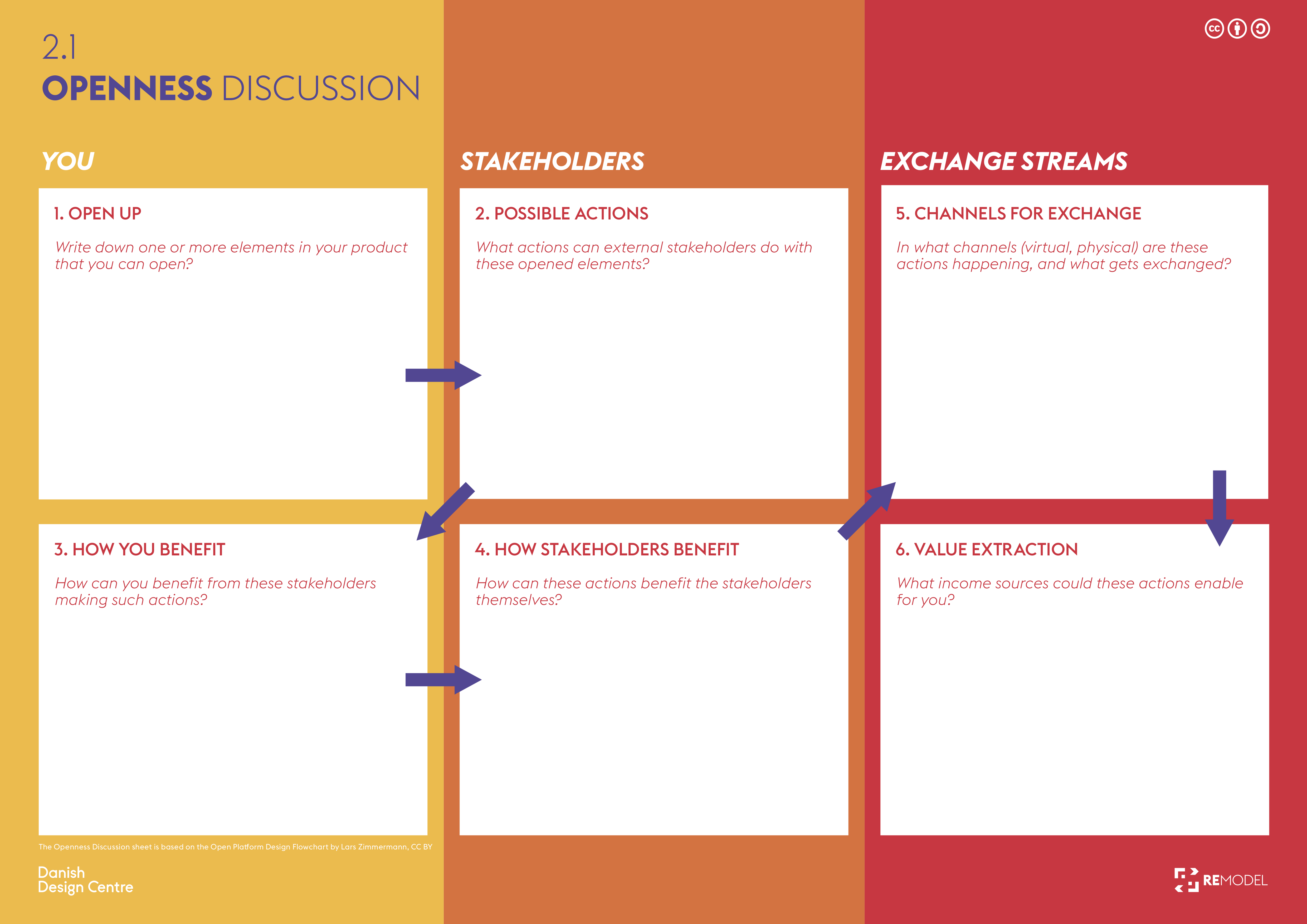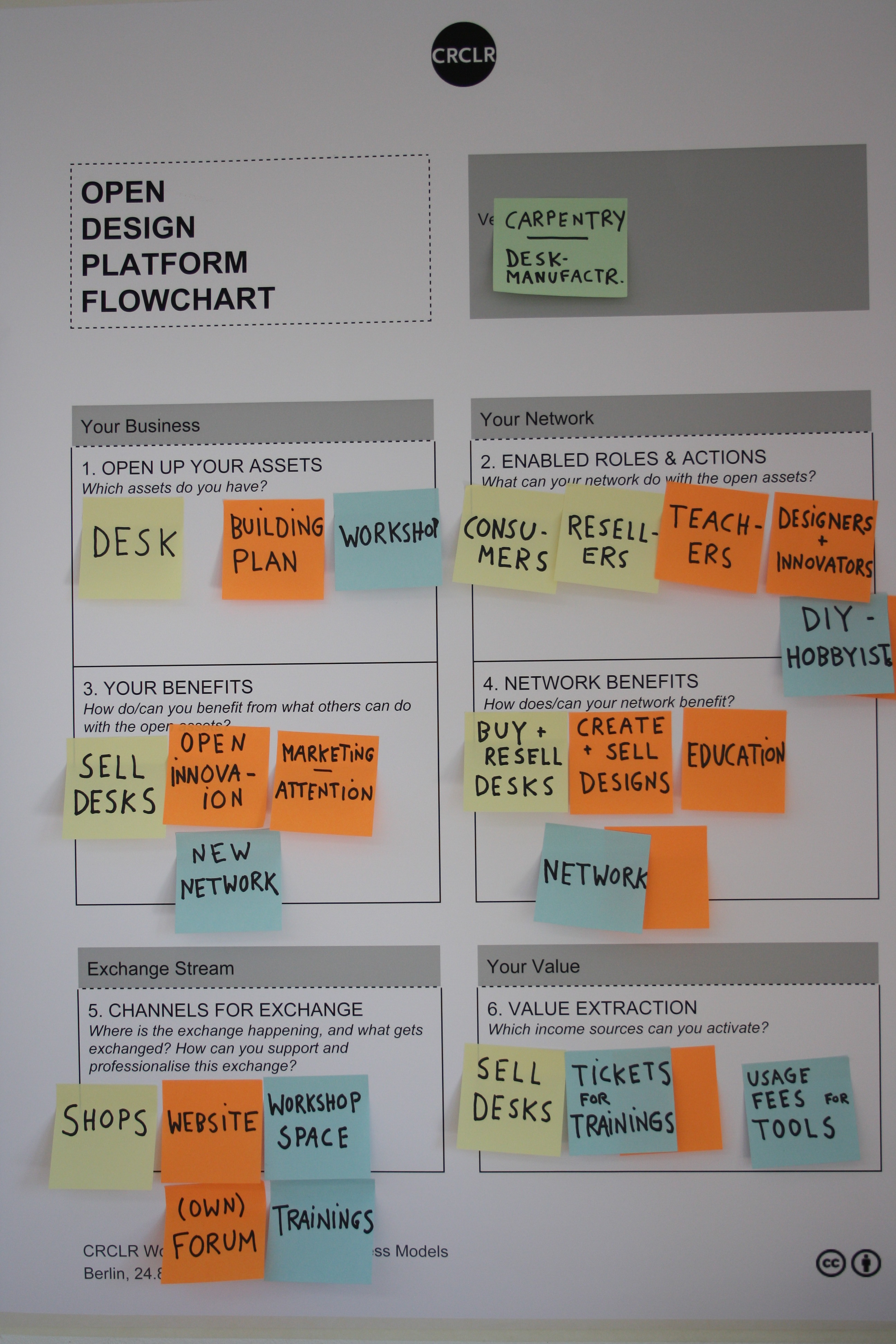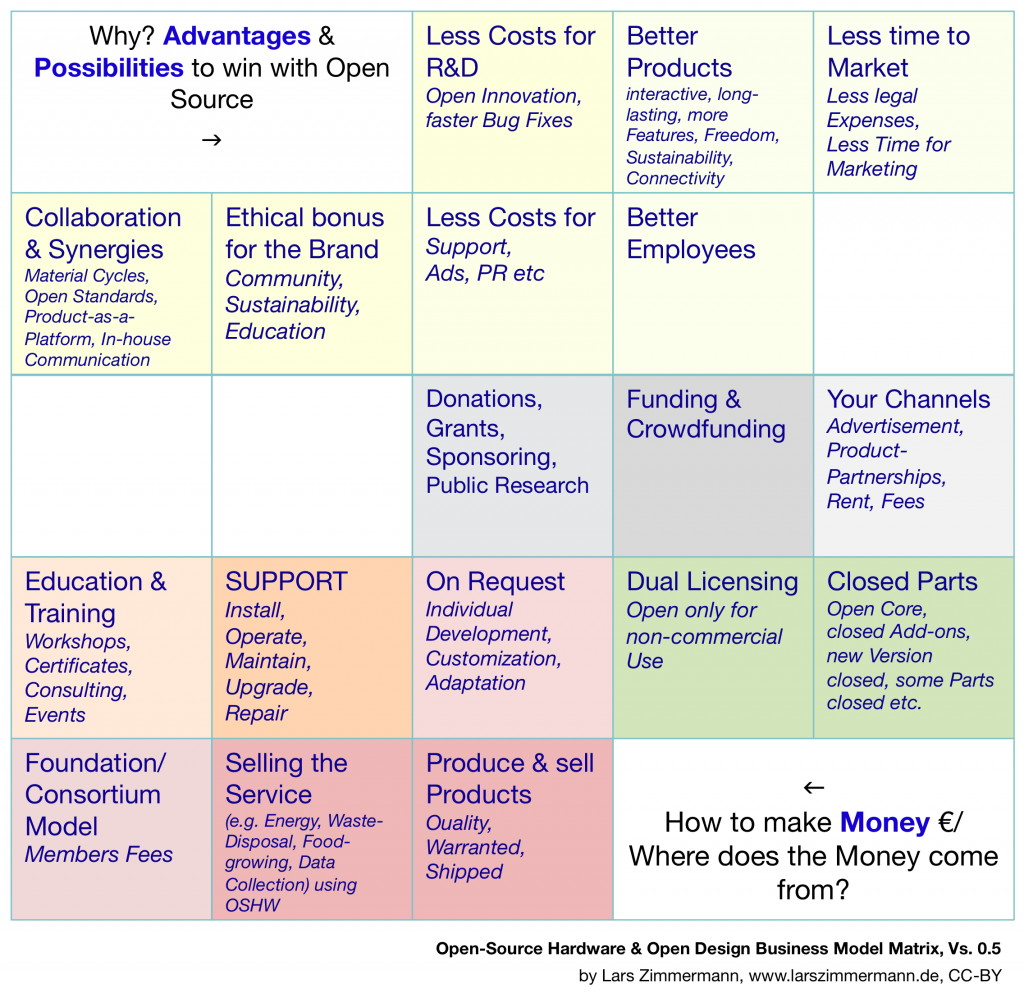Log
- February 18, 2020, @LUM am Teich/Mifactori Studio for GIZ
- February 26, 2020, @LUM am Teich/Mifactori for Circular Rethinking School
- October 28, 2020, DIN Innovationskonferenz 2020
Link
opencircularity.info/business-open
[ o°]
–
Hi,
welcome to this workshop. We will gain an understanding of Open Source (Hardware) and what it means for us when developing a (sustainable) product and a product strategy/business model for it.
Who am I? My name is Lars Zimmermann. I am a designer, artist and activist running a studio for open circular design, environmental activism and bottom up urbanism called Mifactori. In the past years I founded an co-founded a variety of projects – most of them about Open Source and Circularity (for example the Open Source Circular Economy Days or the Open It Agency). I publish articles about approaches to sustainable pre- & post climate change design and cities in books (for example the business chapter in the book “Building Open Source Hardware” or theory at Mifactori.De) and I teach at universities and sometimes schools.
Ok. Let’s start with the workshop.
–
1. What is Open Source Hardware?
Here is an introduction to Open Source Hardware. We will use another “Slide-Show” for this.
(…)
OK. Now after we have seen the information behind the link above we know: Open hardware is about opening up the information about how physical objects (like machines or furniture) are made in order to enable others to copy, remix and use this work. But this does not really explain to us “why should we do this?” So let’s continue there.
–
2. Open Source enables a Future Fit, Sustainable, Circular Economy
Open Source is the potential key to a really sustainable circular economy. It might help us to create a strong resilient economy that will help us to deal with the effects of climate change and create a sustainable smart economy on top. Why?
Open Source Circular Economy (VIDEO)
Open Source Circular Economy (Mission Statement at OSCEdays)
(summarize)
SUMMARY: Patents and closed source approaches are measures to prevent others from doing anything commercial with our products. But circularity means to enable others for this. Enable to repair, reuse, refurbish and recycle!
.
Simple & Accessible is Open & Circular
Open Source might not just be about sharing design files. But it is also about designing for the open regarding the components of a product. Let’s have a look at the third sentence of the Open Hardware Definition:
“Ideally, open source hardware uses readily-available components and materials, standard processes, open infrastructure, unrestricted content, and open-source design tools to maximize the ability of individuals to make and use hardware.”
Make design open! Use simple, reversible techniques in order to enable others to be circular with your products! More about this on the Mifactori Website: Open Design Now! | Open Design Lamps 2020
(More general information about Circular Design is located here in another talk.)
–
3. Open Source (Circularity) and Business
But how to make Business with Open Source? This is usually the first question people ask when they learn about Open Source. This highlights that people are not used to Openness (although they use Open Source Software every day). And while most people can tell you why a closed source businesses work you’ll find only a few who also have some ideas or knowledge about open source ones. We just don’t learn it in school or in the public media. But let’s have a look at it.
The truth is: Almost everything you already know about Business Models can also be applied to Open Source. You just need to gain a better understanding of what Open Source can create – what kind of ecosystem – and then create the right product for this and adjust your business strategy to that.
Let’s first have a quick look at the advantages to gain with open source and then look into how to map an ecosystem.
3.1 Two examples
To understand the stories I am going to tell you I should introduce you to two examples of successful open source ventures. One hardware and one software.
WordPress (Software)
- Video with an explanation of WordPress
- Stories: Websites, Themes, Plugins
- Article: How does WordPress make money
Arduino (Hardware)
- Image of an Arduino Uno
- Stories: Shields, Lilypad, Forums, Quick Open Innovation, Consulting
- Video with an explanation of Arduino
- Update: There was a change with Arduino. But not because of the Open Source aspect. Because they didn’t get their trademark stuff right in their team. But for most Open Source projects it is really important to have your trademark under control. (See also below.)
Summary: Here you see two examples where projects are successful also business-wise NOT DESPITE they are Open Source BUT BECAUSE they are Open Source. And that’s how you need to think about this and plan it.
Both products: WordPress and Arduino would be entirely different products (and maybe not as successful) if they were Closed Source. It is part of their DNA to be open. A product needs to be designed to work for Open Source. Open Sourcing it should not be an afterthought, it needs to be already present at the drawing board.
.
3.2 Trademarks remain closed
This is essential to understand. In Open Source you share how things are made. But your brand name is protected as always. Everyone can copy and sell your toaster. But they can’t do this using your brand. This helps you to answer a lot of questions that might pop up when you dive deeper into Open Source.
“Accordingly, persons or companies producing items (“products”) under an OSHW license have an obligation to make it clear that such products are not manufactured, sold, warrantied, or otherwise sanctioned by the original designer and also not to make use of any trademarks owned by the original designer.”
From the Open Source Hardware Definition (Introduction Part)
–
3.3 Advantages
In 2014 I wrote the business model chapter for the book “Building Open Source Hardware”. The center of that article is this “matrix” listing advantages to gain with Open Source at the top and potential income sources at the bottom. Let’s have a look at the advantages first.
(summarize it quickly)
–
3.4 Ecosystem/Open Platform
But the key is to understand Open Source is what kind of network or ecosystem or if you like to say it like that field of stakeholders you can create with it.
To explain this I created a tool a couple of years back. There is a full MOOC coming with the Tool including 9 Videos and Downloads. You can find all of this here.
In 2018 the Danish Design Center started their REMODEL program. A program to help danish companies into the world of Open Source Hardware. The program created a tool kit of design thinking like tools for these companies and process. These tools are openly available now for everyone to use. And my tool was included into this kit. For this reason we have now a nicely designed version of it available:
 Ok. Then let’s have a look what to think about and plan for when you plan your open product.
Ok. Then let’s have a look what to think about and plan for when you plan your open product.
Example Use (same tool just different design):
 (Explain the tool also with Arduino and WordPress.)
(Explain the tool also with Arduino and WordPress.)
–
Conclusio/Keep In Mind
Open Source is about enabling a lot of other actors to do things with your product you might not have thought of. You might never meet this people and never exchange an email with them. But they contribute to your ecosystem/platform and make it grow. They (might) do this with their own business!
This is the kind of collaborative economy that can enable circularity.
It is the unexpected stories. Try to expect them. And support them where you want to see them happening. But let’ try to find them first.
–
4. Hands On!
Ok. Let’s start with the practical part of the workshop. Build groups. Figure in your group out what already existing or hypothetical product you want to map out as Open Source. Take some workshop materials and create your own flowchart with the tool.
You have: __ minutes.
We will present it in the big group at: __
–
5. Thank You & More Info
Thank you for your attention and work.
If you want to learn more about these topics (for example on how to license open source hardware/open design) pls. visit our websites: Mifactori.De | OpenCircularity.Info | LarsZimmermann.De
*
Here is one more time the link to this page:
opencircularity.de/business-open
[ o°]
If you want to get updates about our work sign up to our:
Newsletter http://eepurl.com/gfjH91
You can find me and also the Mifactori studio on Twitter as:
twitter/@bricktick and twitter/@mifactori
Mifactori tries also to be active on Instagram sharing open designs and city hacks:
instagram/@mifactori
–
. .^. .
°(◠‿◕)°
